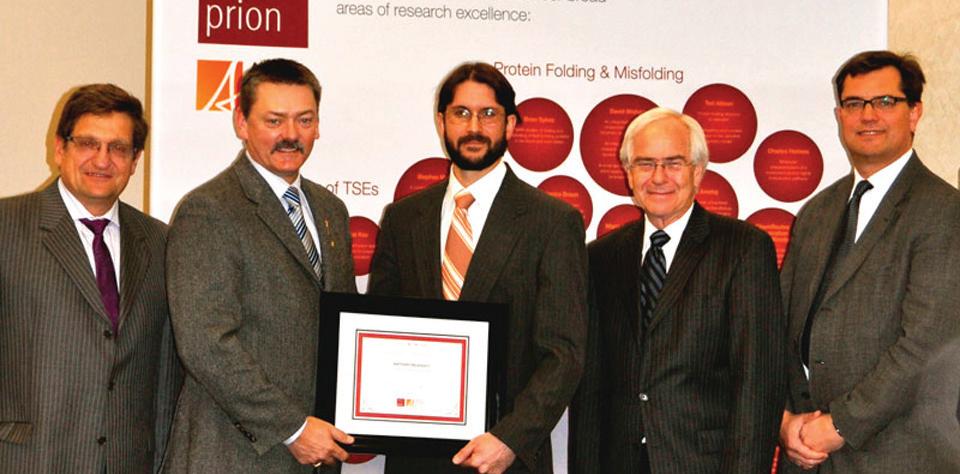
6 minute read
RESEARCH NEWS
McMaster Chemical Engineering professor wins Polanyi Prize
Todd Hoare, assistant professor of chemical engineering at McMaster University, has been awarded a Polanyi Prize in chemistry for 2010 by the Government of Ontario.
Advertisement
Prof. Hoare is one of five recipients selected to receive this annual award recognizing outstanding contributions in the areas of chemistry, physiology/medicine, literature, physics, and economics.
Prof. Hoare was recognized for his research on the potential use of gel nanoparticles to help treat diseases such as diabetes. These nanoparticles would target a certain part of the body, remain in place over the treatment period and be activated when required.
“It’s a tremendous encouragement, particularly when you’re in the early part of your career and a lot of people don’t know what you’re doing,” said Hoare.
This year’s recipients were honoured in Toronto at a ceremony at Massey College on Tuesday, November 30, 2010. Recipients of a Polanyi Prize receive $20,000.
The Polanyi Prizes were established in 1987 by the Ontario government to honour the achievements of John Charles Polanyi, recipient of the 1986 Nobel Prize in chemistry. Five prizes are awarded annually to outstanding young researchers in the early stages of their careers at Ontario universities. Recipients of the Polanyi Prize are selected by a panel established by the Ontario Council on Graduate Studies, an affiliate of the Council of Ontario Universities.
Scientists capture antimatter atoms
Simon Fraser University physics PhD student Mohammad Dehghani Ashkezari and his supervisor professor Mike Hayden have done something that sounds like it came straight out of a science-fiction movie. They are part of an international team of scientists that has managed to capture and hold onto some atomic antimatter. Despite Hollywood plot lines that would have you believe otherwise, this is the first time anyone has actually managed this feat.
“Even though scientists have now been producing antihydrogen atoms for about 15 years, no one has ever managed to hang on to them. Within a tiny fraction of a second, the newly produced antimatter atoms collide with some ordinary matter and disappear in a flash,” Hayden explained. “We’ve managed to create a complicated magnetic bottle in which the anti-matter can be stored, without ever touching the walls.”
Scientists from SFU and four other Canadian universities and research laboratories – University of B.C., University of Calgary, York University, and TRIUMF – are part of the ALPHA Collaboration based at CERN, in Geneva, Switzerland. Altogether, the collaboration involves about 40 scientists from eight countries (Brazil, Canada, Denmark, Israel, Japan, and the UK). A paper describing the groundbreaking anti-matter experiment was published online in the science journal Nature (www.nature.com).
Anti-matter – or more precisely the lack of anti-matter in the universe – has puzzled physicists for decades. It is believed that equal amounts of matter and anti-matter were produced in the early universe, but for some unknown reason matter won out. Almost nothing is left.
“Now that we can hold anti-matter atoms in a bottle, it becomes possible to perform careful measurements of their properties. We plan to look for minute differences between matter and antimatter atoms. Even a small difference might give us a clue as to where the anti-matter went,” said Hayden. “This experiment will address some truly fundamental questions about the universe.”
Clinical Trials & Patents
n YM BioSciences (Mississauga, ON) reports positive interim data including substantial anemia response from its Phase I/II trial of JAK1/JaK2 inhibitor CYT387, in myelofibrosis. The results were reported in an oral presentation at the 52nd American Society of Hematology (ASH) Annual Meeting held in Orlando, FL. “Anemia is the most serious symptom associated with myelofibrosis, so I am highly encouraged by the emerging activity profile of CYT387, which uniquely continues to demonstrate a substantial ability to improve anemia while producing similar results to its peers in reducing spleen size and controlling constitutional symptoms,” noted Dr. Alayew Tefferi, chair of the Study. “I also encourage YM to evaluate CYT387 in other diseases where anemia has a significant impact.” “These unprecedented results highlight the potential safety and efficacy advantages of CYT387 compared with other JAK inhibitors. If CYT387 continues to demonstrate this unique anemia benefit in larger trials, it may ultimately serve as a drug of choice for the majority of patients with myelofibrosis who find anemia problematic,” said Dr. Nick Glover, president and CEO of YM BioSciences. “We look forward to updated data from the full 140 patient trial in calendar mid-2011.”
n Resverlogix Corp. (Calgary, AB) has filed additional new patent protection based on novel findings derived from its recently completed ASSERT Phase 2 clinical trial. A new patent application has been filed for novel dosing combinations of RVX-208 and leading statin therapeutics. Resverlogix’ findings in a post-hoc analysis of ASSERT data revealed that RVX-208 in certain doses along with leading statin drugs markedly improved not only ApoA-I production, HDL and large HDL particles, but also important aspects of LDL and ApoB particles. “The bonus finding of ApoB and LDL lowering while on statins and not in placebo’s was a surprise finding and is useful in selecting the best statin co-medications going forward for maximum treatment effect. The effects seem most efficacious in the leading stains, being Pfizer’s Lipitor and AstraZeneca’s Crestor. Resverlogix will further delineate this positive synergistic effect from a mechanistic point of view,” stated Dr. Jan Johansson, senior vice president of Medical Affairs of Resverlogix. “To have these additional findings of unexpected enhanced statin performance, in combination with RVX-208, offers us an added approach to providing an array of new therapies to reduce atherosclerosis and coronary vascular disease,” Dr. Johansson added.

Nathan Deleault, International Young Researcher Prize Winner (center) is flanked by officials from the Alberta Prion Research Institute and the government of Alberta at the award presentation Edmonton.
To celebrate its fifth anniversary and promote work being done in prion and protein misfolding research, the Alberta Prion Research Institute is recognizing the work young researchers are accomplishing on the international scene.
Nathan Deleault was awarded with the Alberta Prion Research Institute’s International Young Researcher Prize.
Deleault’s paper “Formation of native prions from minimal components in vitro” was selected by an international jury as having the most innovative findings and anticipated future impact in the field of prion and prion-like protein misfolding science.
Deleault started his prion work as a research technician is 2001 and quickly developed into a talented, insightful and rigorous scientist conducting independent research as a research associate in Dr. Suppattapone’s lab in Dartmouth College.
Deleault’s paper “Formation of native prions from minimal components in vitro” reports two major advances: That infectious prions can be produced spontaneously; and can be formed outside of cells. This provides an explanation for the longstanding paradox that prion diseases can arise sporadically in patients that were never exposed to infectious prions. Another finding was that infectious prions can be formed from a minimal cocktail of defined components. That finding demonstrates that infectious prions do not contain coding nucleic acids or accessory proteins. Cofactors are necessary in prion formation in vitro, and this finding suggests they may also play an important structural role in maintaining the infectious properties of prions.
There is prion and protein misfolding research being done around the world to help find solutions around diseases such as bovine spongiform encephalopathy (BSE, also known as mad cow disease). More than 130 Alberta student and young professionals have been supported, in the last five years, by the Alberta Prion Research Institute. Forty-five research projects have been funded, worth more than $30 million, to help find solutions to the serious scientific and socioeconomic challenges associated with prion and protein misfolding diseases.
The International Young Researcher prize is a celebration of the work of hundreds of up-and-coming researchers who are contributing to the collective knowledge in this field of science, those working towards creating the next generation of solutions.
Our work gives hope –
Hope to millions suffering from chronic disease — prolonging life, easing pain. Our work delivers better health care and faster recoveries, through prevention as well as cure. Our work in Canada helps save lives here at home and around the world through innovative research into medicines and vaccines.




